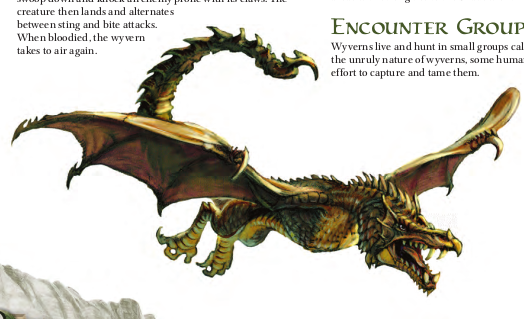Let's Read the 4e Monster Manual/Vault: Wyvern

This article is part of a series! Click here to see the other entries.
Wyverns have been in the game since its beginnings (or at least since BECMI). Here, they are present only on the Monster Manual.
The Lore
Wyverns are the most famous “not-quite-dragons” of D&D, and the ones most likely to be confused with real dragons from a distance. The most obvious visual difference is that wyverns lack front legs.
There are others, too, which become more evident when you interact more closely with them. Unlike dragons, wyverns are non-sapient animals, and they also lack magical breath weapons. Instead, they have a stinger at the tip of their tails that can inject prey with a potent venom. They’re not as relentlessly voracious as some of the other fantastic predators described in this book, but I imagine they still might put a strain on any herds on their chosen territory.
In the wild, wyverns live in small groups called “flights”, which roost in high places like mountains and hunt the surrounding region together. If you see a flight of wyverns up close, it’s because they’re trying to eat you.
Wyverns can be tamed, but the process has to start shortly after they’re born. As you might expect, there’s a market for eggs and hatchlings, and sapient opponents might bring their pet wyverns to the fight.
The Numbers
We get stats for two species of wyverns here. Both are Large Beasts with the Reptile keyword, and fight with their natural weapons: a bite, claws, and the stinger. Wyverns are good fliers and much more agile in the air than on the ground.
Note that wyvern damage as written is notoriously weak. Fixing this to use the updated math should be a priority before you include them in an encounter.
Wyvern
The more common variety is a Large Natural Beast with the Reptile and Mount Keywords, and a Level 10 Skirmisher with 106 HP. Their land speed is 4, and their flight speed is 8 with Hover.
Wyverns have two basic attacks: a bite with no special effects beyond damage, and a slightly weaker attack with their claws, which can only be done from the air and knocks prone on a hit. Flyby Attack allows them to fly their speed and make one of these attacks at any point along the way without drawing opportunity attacks.
They can also sting, of course, which does a little less damage than the claw and triggers a secondary attack vs. Fortitude that deals ongoing poison damage on a hit (save ends).
If used as a mount, the wyvern’s aerial agility gives its rider +2 to all defenses.
I’m guessing the wyvern doesn’t bite very often. It’s going to use flyby attacks to knock people prone, or sting if that’s not practical. Only a prone, poisoned target will get the bite.
Fell Wyvern
A larger species which originated in the Shadowfell but is also present in places where that plane intersects with the world. It’s a Large Shadow Beast and a Level 24 Skirmisher with 228 HP. Despite not being undead, it has Resist 10 Necrotic and Vulnerable 5 Radiant. Its land speed is 6, and its fly speed is 12 with Hover.
Fell Wyverns fight mostly like wyverns with bigger numbers, and have all the same attacks. Their venom causes “necrotic and poison” damage, so it’s harder to resist. They can also use a pestilent breath (close blast 5 vs. Fortitude; recharge 5-6) that does immediate and ongoing necrotic damage.
Sample Encounters and Final Impressions
There’s a single sample encounter: level 10, an ettin marauder, a basilisk, and 2 wyverns.
I also imagine either wyvern is a pretty close fit to those fell beasts the Ringwraiths rode in Lord of the Rings, though their actual level would depend on how high-powered you view that story as.
Given that wyverns can be mounts, the most clichéd use for them would be to have them as the “hostile humanoid” flying mount of choice, to have proper aerial fights against human gryphon cavalry.